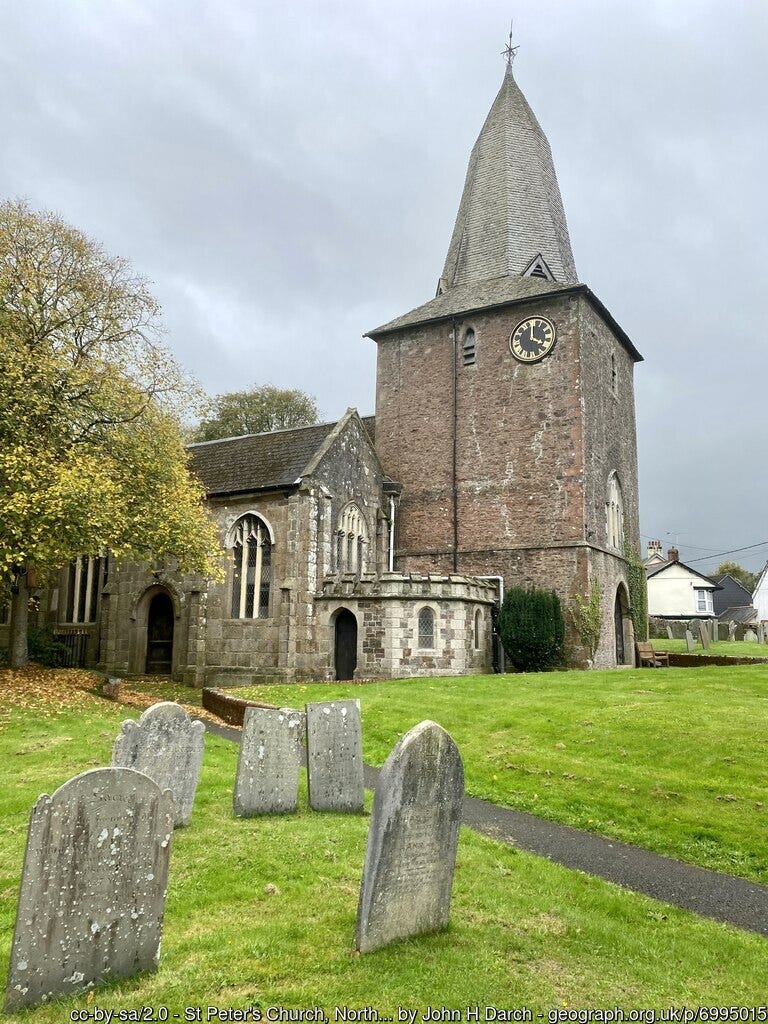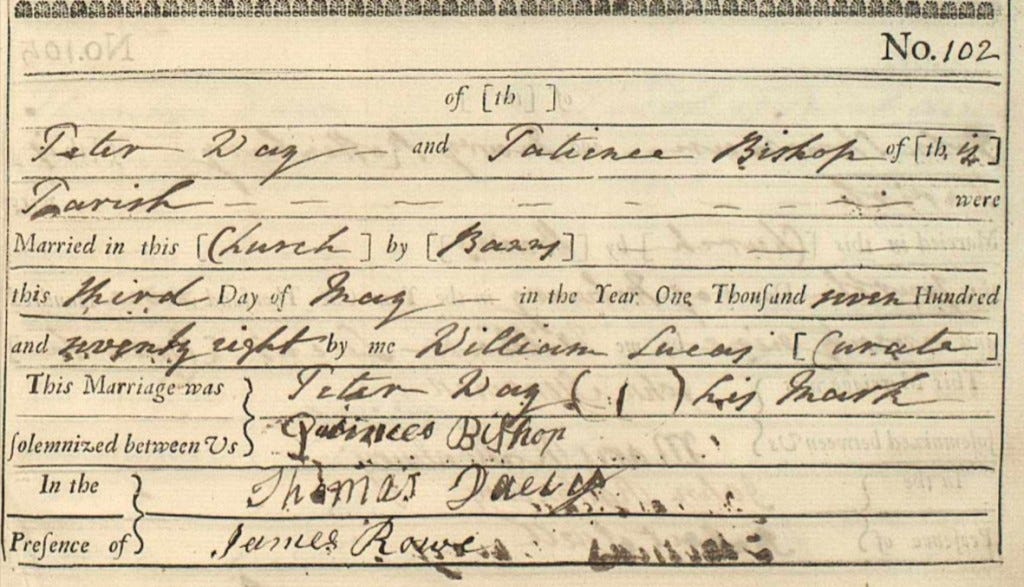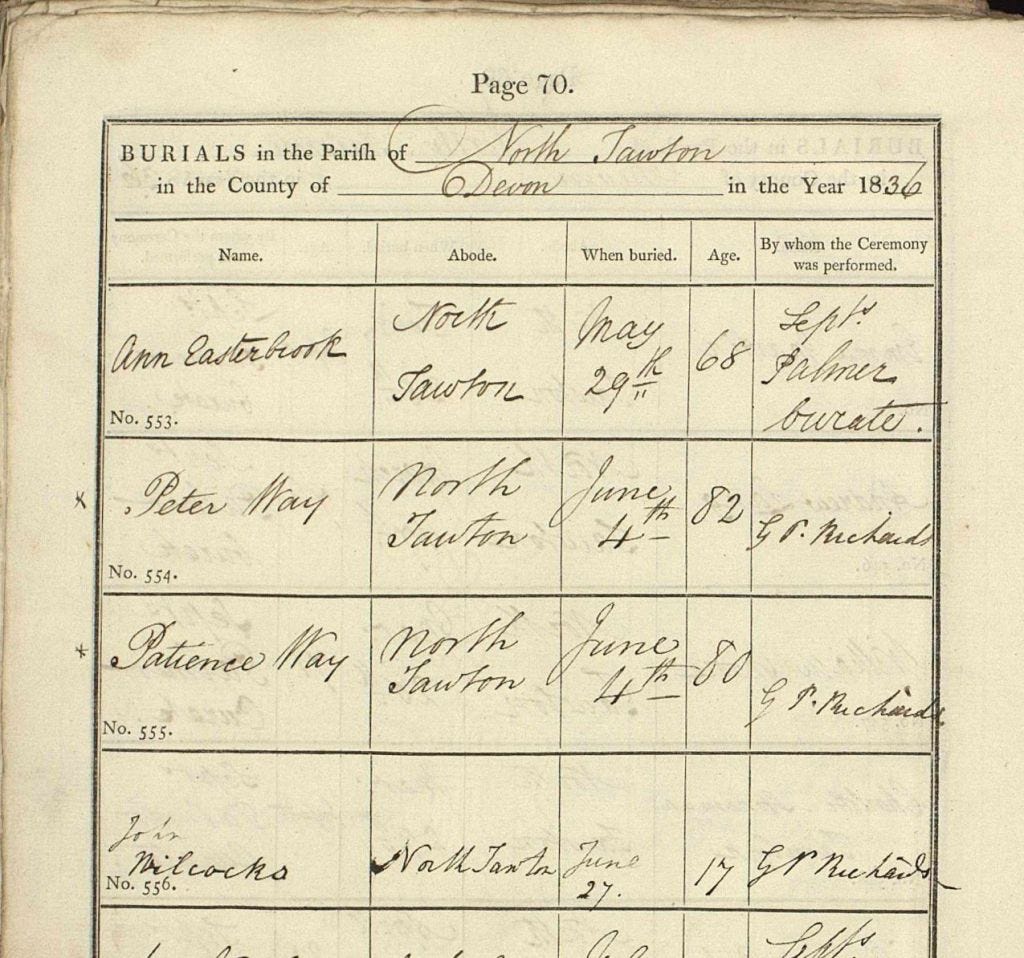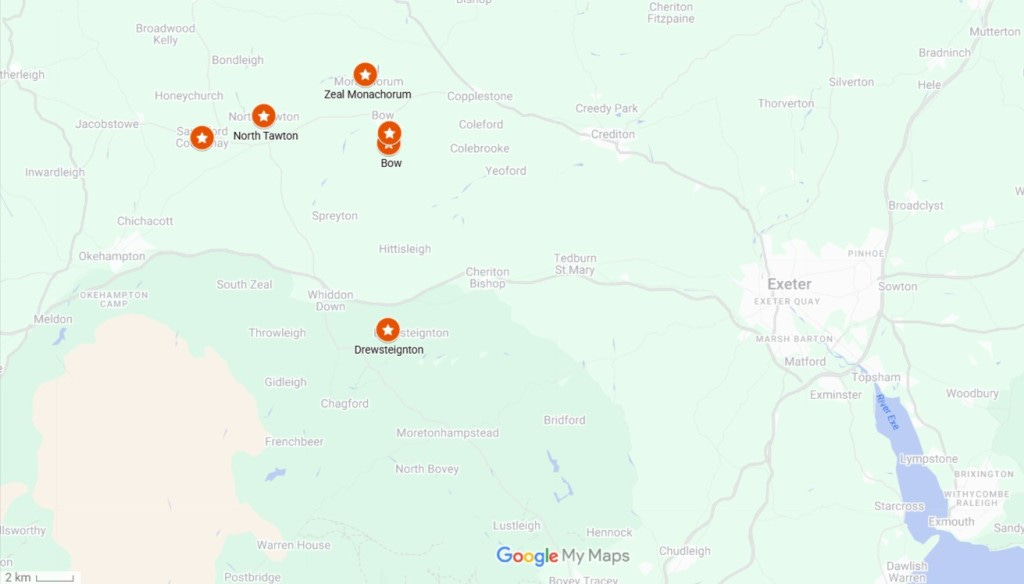Two of my husband Greg’s 5th great grandparents were Peter and Patience Way from North Tawton in Devon.
North Tawton, on the Taw river, was already a market town by the end of the 12th century. For many centuries agriculture and the woollen industry provided the chief sources of employment. The last town woollen mill closed in 1930 and it seems the woollen industry was already in decline by the 1830s. According to a Topographical Dictionary of England published in 1831 the town then had a population of 1563 and the Dictionary states “Here was once an extensive woollen manufacture, and there is still a spinning- mill.”

Peter Way was born in 1754 in North Tawton, the son of Mary and Francis. He was baptised on 9 August 1754.
Patience Bishop was born in 1757 in North Tawton, the daughter of John and Elizabeth. She was baptised on 15 July 1757.
Patience Bishop married Peter Way in North Tawton on 3 May 1778. On the record of the banns Peter was described as a husbandman. Peter signed with his mark; Patience signed her name.

They had nine children:
Francis 1778–1854
Elizabeth 1780–1817
John 1782–1841
Peter 1785–1857
Ann 1787–1865
George 1791–
Richard 1794–1819
James 1796–1867
Thomas 1800–1875
In 1778 shortly after their marriage Peter and Patience moved to Nymet Tracey, five miles east of North Tawton. Their son Francis was baptised there on 4 November 1778. The next three children, Elizabeth, John, and Peter, were also baptised there.
In 1781 there was a census in the Parish of Bow. (Bow had absorbed the adjacent hamlet of Nymet Tracey). There were 734 parishioners enumerated, among them were Peter, Patience, Francis, and Elizabeth Way. Their address was recorded as Gays Lake.
In 1787 Peter and Patience’s daughter Ann was baptised at Zeal Monachorum, three miles north of Nymet Tracey (Bow). Four years later their son George was baptised at Drewsteignton, fourteen miles to the south of Zeal Monachorum. In 1794 the next son Richard was baptised at Sampford Courtenay, eleven miles north-east of Drewsteignton and two miles west of North Tawton. Two years later James was baptised at North Tawton and in 1800 the youngest of their nine children was also baptised there.
In the early nineteenth century England was preparing for an invasion by the French; Napoleon had declared war again. The English government issued instructions that each and every parish council should make plans to deal with an invasion. The North Tawton response was a census. About 9 or 10 of the leading citizens went from house to house and collected the names and true ages of the people in each household as well as their trade and the physical condition of the older inhabitants. The town census lists almost 1200 men, women and children who were standing by, ready to be evacuated if the need arose.
Peter Way, labourer, aged 49, and Patience Way, wife, aged 46, were listed on the North Tawton census of 1803. Immediately below and probably in the same household were listed:
Elizh Way, weaver, aged 22
Richard Way, child, aged 9
James, child, aged 7
Thomas, child, aged 3
Mary Moor, child, aged 1
Thomas Bishop, labourer, aged 60
I am not sure how Mary Moor or Thomas Bishop are related. A base born [illegitimate] child Mary, daughter of a Jane Moore, was baptised at North Tawton in February 1802. It seems she was being cared for by the Way family. As for Thomas Bishop, he was very probably a relative of Patience Way, but the census transcription does not clearly show where a ‘household’ begins and ends, and he was possibly a member of the next household in the series.

Both Patience and Peter died in June 1836 in North Tawton. They were buried on 4 June, probably in the same grave and at the same time. Peter was aged 82, Patience 80. They had been married for 58 years.
The deaths occur before civil registration so there are no certificates. The burial register does not record the causes of death and offers no comment on the double burial. I can find no newspaper reports of the double death and burial.
How common are husband and wife deaths where the second follows shortly after the first, such as the deaths of Peter and Patience Way?
Actuaries know.
An article in The Actuary of January 1994 discusses simultaneous death of couples, ‘simultaneous’ defined as ‘on the same day or within 30 days’ of each other’. A survey was conducted of twenty-nine life assurance companies to examine the phenomenon. The incidence of double deaths of this kind was found to be very low, reported as 0.4 per 1,000. There were only seven simultaneous deaths: four aviation accidents and three auto accidents. Clearly the couples had died together in the crashes, at the time or shortly after.
In my family tree, which records the deaths of several thousand husband and wife couples, I have at least two instances (beside the case of Peter and Patience Way) where they died within thirty days of each other.
Greg’s maternal grandparents, Arthur and Stella Sullivan, died within three weeks of each other. They had been married for 62 years. My father’s maternal grandparents, Arthur and Kathleen Cudmore, died within nine days of each other. These were not deaths resulting from an accident.
Do you have instances in your family tree of husband and wife dying one shortly after the first?
Related posts and further reading
Luff, J., & Vose, B. (1994). Study of simultaneous deaths under second-to-die policies. The Actuary, 28(1), 12. https://www.soa.org/globalassets/assets/library/newsletters/the-actuary/1990-99/1994/january/act-1994-vol28-iss01-luff-vose.pdf
Wikitree:
Patience (Bishop) Way (1757-1836)
Peter Way (1754-1836)



Ah, yes, take me back to beautiful Devon. My second great grandfather, William Allery was born in Blackawton, Devon. He was baptised at St Saviours on 19 February 1817. Your post has prompted me to return to his profile and fill in some gaps.